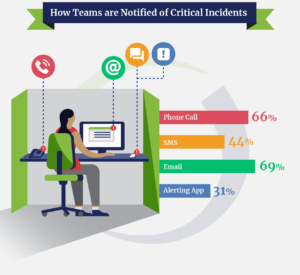OnPage Publishes 2019 Incident Management Trends Report

The report offers detailed, industry information including, but not limited to, (1) top IT and MSP concerns or challenges, (2) how teams are notified of critical incidents, (3) how many critical incidents IT and MSP teams experience within a year and (4) teams’ use of on-call scheduling systems to coordinate 24×7 support.
Here are some valuable, key takeaways or themes covered in the report:
Top Concerns for IT and MSP Teams
The majority of IT respondents—63 percent—answered that security is a top concern for their teams. Additionally, they’re concerned with hiring and retaining talent (48 percent) and having more influence in their organizations (43 percent).
These findings indicate that IT teams need to integrate a balanced workload approach into their incident management practices, preventing attrition and reducing employee burnout in the process. Also, a balanced workload approach to incident management can be used as an incentive for hiring and retaining top talent.
Additionally, the implications for incident management are that IT teams need to better prepare for security incidents, which in turn reduces their resolution time during a breach.
Alternatively, the majority of MSP respondents—79 percent—are concerned with increasing their revenue. They’re also interested in streamlining their operations and hiring and retaining talent, at 52 percent and 36 percent, respectively. This indicates that MSPs are putting an emphasis on business-related challenges, and they’re likely to consider an incident management solution that helps them achieve desired organizational results.
How Teams Receive Critical Alerts

Here, at OnPage, we’re all about providing persistent, reliable and secure, mobile alerts for IT and MSP pros. That said, we’re alarmed to see that only 31 percent of respondents use smartphone alerting apps to receive critical notifications; other ways of receiving critical alerts such as email and phone calls are unreliable.
Email inboxes don’t just get flooded with spam, but they also ensure that teams miss critical alerts due to (1) indistinguishable pings for high and low-priority notifications and (2) important notifications getting buried under other, unimportant messages. Much is the same with phone calls, as teams are unable to differentiate between urgent and non-urgent matters.
These findings indicate that teams are using antiquated and legacy technologies to receive alerts on critical, 21st century problems. Organizations need to review their incident management approaches, ensuring that their practices reduce time-to-response rather than adding delays (e.g., phone tag). Also, organizations need to determine whether or not their incident management approaches provide a clear, efficient and effective process for every situation.
Quantity of Critical Incident Alerts Received
IT and MSP teams are dedicated to satisfying their stakeholders or clients. But, how often do they juggle critical incidents to achieve such satisfaction?
According to our latest report, respondents had varied experiences regarding the number of incidents reported over the past 12 months. For instance, 31 percent of respondents answered that they’ve experienced one- to-five critical incident alerts, while 35 percent reported more than 21 incidents.
For the cohort that experienced more than 21 incidents per month: You need to ensure that your team is using an effective incident management process that’s equipped with:
- Intelligent alerting
- Clear on-call and escalation policies
- Detailed audit trail reporting
In this way, overly busy teams can continue to achieve the same level of customer excellence or stakeholder satisfaction—regardless of the quantity of critical incident notifications.
Teams’ Use of On-Call Scheduling for 24×7 Support
Twenty-four seven support is a fact of life for most IT and MSP teams, and I’m pleased to report that the most popular response to the question on what type of scheduler is used—27 percent—was the digital, on-call scheduler included in an incident alert platform to achieve after-hours support excellence. This suggests that teams are benefitting from easy-to-use digital calendars, allowing them to better manage their on-call scheduling procedures.
The full report is now available on the OnPage site, providing further details on these findings and other relevant, IT and MSP-based data points. Want to get the full analysis and industry statistics? Download the full, comprehensive report here and contact us to learn more.






